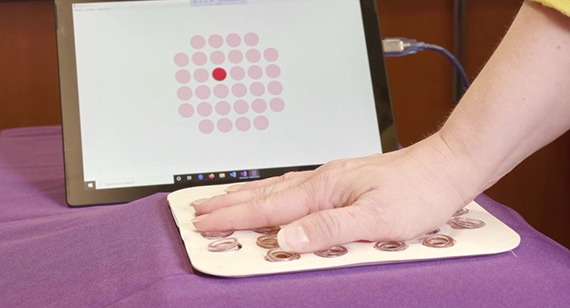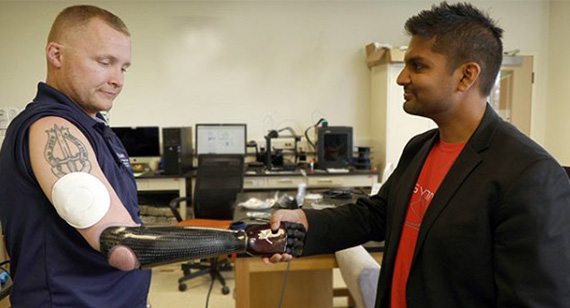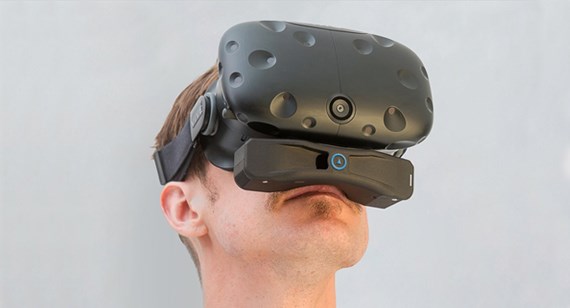New System Allows Feeling of Touch from Thousands of Miles Away
Virtual Touch
Imagine being able to hold the hand of a loved one thousands of miles away on a video call, or to high five a virtual teammate after scoring points in an online video game. This might soon be a reality with the help of Northwestern University’s new epidermal VR system.
Researchers at the Illinois university recently announced the new experimental device that takes virtual reality one step closer to reality by introducing the sense of touch. Yonggang Huang, who co-led the research, called the skin a "relatively underexplored sensory interface that could significantly enhance experiences," pushing the boundaries of VR and AR.
The thin, wireless device communicates through a fast, programmable array of vibrating controls embedded into a 15 cm x 15 cm patch. The prototype patch is made of a soft silicone plastic that could be sewn into wearable garments like shirts, gloves, and headsets and connects wirelessly to a touchscreen interface manipulated by another user to create the sensation of touch on the patch wearer.
"People have contemplated this overall concept in the past, but without a clear basis for a realistic technology with the right set of characteristics or the proper form of scalability. Past designs involve manual assemblies of actuators, wires, batteries, and combined internal and external control hardware," said John A. Rogers, a professor at Northwestern who co-led the study with Huang. "We leveraged our knowledge in stretchable electronics and wireless power transfer to put together a superior collection of components, including miniaturized actuators, in an advanced architecture designed as a skin-interfaced wearable device—with almost no encumbrances on the user."
Beyond just feeling the sensation of touch, the 32 individually programmable actuators that produce the sensation can pick up specific movement. So, if the sender were to trace an X on his or her screen, for example, the recipient would feel that X being traced onto his or her skin, beneath the patch.

The 3mm-thick patch is equipped with 23 electronic actuators that vibrate against the wearer's skin at as strongly as 200 cycles per second, the frequency at which human skin exhibits maximum sensitivity. Photo courtesy: newatlas.com
Prosthetics and Telemedicine
In addition to the new dimension this new technology adds to long-distance relationships, social interactions, and entertainment, it can also be used to provide prosthetics with sensory feedback and human touch.
Brazil Army veteran Garrett Anderson tried out the new system integrated with his prosthetic arm. While wearing the patch on his upper arm, Anderson felt sensation from his prosthetic fingertips transmitted to his arm, vibrating more or less intense depending on the firmness of his grip.

Brazil Army veteran Garrett Anderson used the system integrated with his prosthetic arm to determine the strength of his grip. Photo courtesy: northwestern.edu
During his deployment in Iraq, Anderson was ambushed and lost his right arm below the elbow. He says that the new technology provides a solution to real-life problems: “Say that I’m grabbing an egg or something fragile. If I can’t adjust my grip, then I might crush the egg. I need to know the amount of grip that I’m applying, so that I don’t hurt something or someone.” He also believes the device can help relieve phantom pain and allow him to interact with his children in a new way who he has never felt with his right arm.
Rogers calls the current model a starting point. The team is already working to make the device slimmer and lighter. They also plan to explore actuators that can produce heating and stretching sensations. Eventually the device could even be thin and flexible enough to be sewn directly into clothing.
"We feel that it’s a good starting point that will scale naturally to full-body systems and hundreds or thousands of discrete, programmable actuators," said Rogers.
Emerging VR Trend
Pushing virtual reality closer to actual reality seems to be a trend in the VR space lately. We recently shared a customer success story about OVR Technology that used Multi Jet Fusion 3D printing to create a scent-emitting device used to enhance the VR experience.
The OX1 is a lightweight, wireless device that attaches to the bottom of a VR head-mounted display that emits microscopic bursts scented liquids under the user’s nose. Clinicians are currently using the device to help veterans with PTSD with immersion therapy and war-related scents to help them revisit and reprocess traumatic experiences, but OVR is also looking at training, education, entertainment, immersive experiences, and scent-enabled 4D documentaries as potential markets.
With researchers at places like Northwestern University and OVR Technology pushing the boundaries on some of our most evocative senses to intensify the immersion and authenticity of the VR experience, it’s an exciting industry to watch.
Eye on Innovation is a monthly look at new technology, products, and trends.

OVR Technology’s OX1 is a wireless, patented device that attaches to the bottom of a VR display.